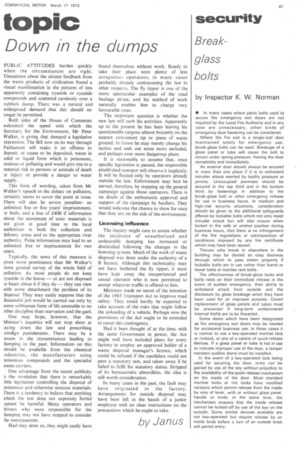s ecur ity Break
Page 49

If you've noticed an error in this article please click here to report it so we can fix it.
glass bolts
by Inspector K. W. Norman • In many cases where panic bolts used to secure fire emergency exit doors are not required by the Local Fire Authority and in any case are unnecessary, other kinds of emergency door fastening can be considered.
Where the fire exit is a single-leaf door maintained solely for emergency use, break-glass bolts can be used. Breakage of a glass panel or tube will cause the bolt to retract under spring pressure, freeing the door completely and immediately.
An exterior door should always be secured in more than one place if it is to withstand intruder attack exerted by bodily pressure or jemmy. Unoccupied premises should be secured in the top third and in the bottom third, by fastenings in addition to the break-glass bolt or other emergency release for use in business hours. In medium and high-risk security situations, consideration should be given to the additional safeguards offered by lockable bolts which not only resist intruder attack but will also ensure when locked in the safe or unshot position during business hours, that there is no infringement of the fire regulations or contravention of conditions imposed by any fire certificate which may have been issued.
Thieves who break in elsewhere in the building may be denied an easy doorway through which to pass stolen property if lockable bolts are in use rather than barrel or tower bolts or mortise rack bolts.
The effectiveness of break-glass locks and bolts rests on their immediate release in the event of sudden emergency, their ability to withstand attack from outside and the disclosure by glass breakage when they have been used for an improper purpose. Covert replacement of glass panels and tubes must be prevented if long-term undiscovered internal thefts are to be thwarted.
Some doors which have been designated as fire emergency exit doors may be needed for occasional business use. In these cases it is normal to use a key-operated mortise lock or rimlock, or one of a variety of quick-release devices. If a glass panel or tube is not in use to indicate improper use of the door, a tamper resistant audible alarm must be installed.
In the event of a key-operated lock being used for securing the door, entry can be gained by use of the key without prejudice to the availability of the quick-release mechanism on the inside of the door. Most standard mortise locks or rim locks have modified versions which permit release from the inside by. way of lever, with or without glass panel, handle or knob; at the same time, the mechanism ensures that the inside release cannot be locked-off by use of the key on the outside. Some similar devices available are not key-operated but require release by an inside knob before a turn of an outside knob will permit entry.










































































































